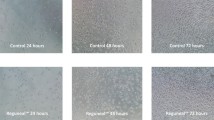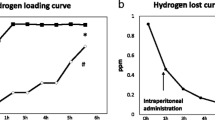Abstract
Of the glucose degradation products (GDPs) in glucose-rich peritoneal dialysate, we investigated the influence of 3,4-dideoxyglucosone-3-ene (3,4-DGE) on the cytotoxicity of acidic heat-sterilized peritoneal dialysis fluid (L-H PDF) using human peritoneal mesothelial cells (HPMC). We prepared acidified filtration-sterilized PDF (glucose concentration 3.86%) containing eight types of added GDP [3,4-DGE, glyoxal (GO), methylglyoxal (MGO), 3-deoxyglucosone (3-DG), formaldehyde (FA), acetaldehyde (AA), 5-hydroxymethyl-2-furaldehyde (5-HMF), and furfural (FF)] or seven types of GDP (GO, MGO, 3-DG, FA, AA, 5-HMF, and FF). HPMC were exposed to these two types of solution and acidic heat-sterilized PDF (glucose concentration 3.86%, L-H 3.86) for 4 h. Cell viability was determined by 3,(4,5-dimethythiazol-2-yl)2,5-diphenyl-terazolium bromide (MTT) assay. MTT viability was decreased significantly compared with the control when treated with L-H 3.86 or acidified neutral filtration-sterilized PDF (glucose concentration 3.86%) containing eight GDPs. However, no significant decrease in MTT viability was observed when HPMC were treated with acidified neutral filtration-sterilized PDF (glucose concentration 3.86%) containing seven GDPs. Thus, 3,4-DGE strongly affects the cytotoxicity of L-H PDF. It is suggested that the cytotoxicity of L-H PDF is based on the presence of 3,4-DGE.
Similar content being viewed by others
References
JW Dobbie (1992) ArticleTitlePathogenesis of peritoneal fibrosing syndromes (sclerosing peritonitis) in peritoneal dialysis Perit Dial Int 12 IssueID1 14–27 Occurrence Handle1347465 Occurrence Handle1:STN:280:DyaK387ot1Smtg%3D%3D
J Witowski K Korybalska J Wisniewska A Breborowicz GM Gahl U Frei J Passlick-Deetjen A Jorres (2000) ArticleTitleEffect of glucose degradation products on human peritoneal mesothelial cell function J Am Soc Nephrol 11 IssueID4 729–739 Occurrence Handle10752532 Occurrence Handle1:CAS:528:DC%2BD3cXisFertL0%3D
N Di Paolo G Garosi L Traversari M Di Paolo (1993) ArticleTitleMesothelial biocompatibility of peritoneal dialysis solutions Perit Dial Int 13 IssueIDSuppl 2 S109–112 Occurrence Handle8399542
A Breborowicz H Rodela J Karon L Martis DG Oreopoulos (1997) ArticleTitleIn vitro simulation of the effect of peritoneal dialysis solution on mesothelial cells Am J Kidney Dis 29 404–409 Occurrence Handle9041217 Occurrence Handle1:STN:280:DyaK2s7ptlKgsA%3D%3D
J Witowski J Wisniewska K Korybalska TO Bender A Breborowicz GM Gahl U Frei J Passlick-Deetjen A Jorres (2001) ArticleTitleProlonged exposure to glucose degradation products impairs viability and function of human peritoneal mesothelial cells J Am Soc Nephrol 12 2434–2441 Occurrence Handle11675420 Occurrence Handle1:CAS:528:DC%2BD3MXotl2ls78%3D
C Lage M Pischetsrieder C Aufricht A Jorres H Schilling J Passlick-Deetjen (2000) ArticleTitleFirst in vitro and in vivo experiences with Stay-Safe Balance, a pH-neutral solution in a dual-chambered bag Perit Dial Int 20 IssueIDSuppl 5 S28–32 Occurrence Handle11229609
N Topley D Kaur MM Petersen A Jorres J Passlick-Deetjen GA Coles JD Williams (1996) ArticleTitleBiocompatibility of bicarbonate-buffered peritoneal dialysis fluids: influence on mesothelial cell and neutrophil function Kidney Int 49 1447–1456 Occurrence Handle8731113 Occurrence Handle1:CAS:528:DyaK28Xkslagtrs%3D
J Witowski N Topley A Jorres T Liberek GA Coles JD Williams (1995) ArticleTitleEffect of lactate-buffered peritoneal dialysis fluids on human peritoneal mesothelial cell interleukin-6 and prostaglandin synthesis Kidney Int 47 282–293 Occurrence Handle7731159 Occurrence Handle1:CAS:528:DyaK2MXkvVSqs7Y%3D
AS De Vriese S Mortier NH Lameire (2001) ArticleTitleWhat happens to the peritoneal membrane in long-term peritoneal dialysis? Perit Dial Int 21 IssueIDSuppl 3 S9–18 Occurrence Handle11887871
JY Do YL Kim JW Park KH Cho TW Kim KW Yoon CD Kim SH Park JH Han IH Song (2005) ArticleTitleThe effect of low-glucose-degradation-product dialysis solution on epithelial-to-mesenchymal transition in continuous ambulatory peritoneal dialysis patients Perit Dial Int 25 IssueIDSuppl 3 S22–25 Occurrence Handle16048250 Occurrence Handle1:CAS:528:DC%2BD2MXmt1Chtrg%3D
K Wieczorowska-Tobis A Polubinska TP Schaub H Schilling J Wisniewska J Witowski J Passlick-Deetjen A Breborowicz (2001) ArticleTitleInfluence of neutral-pH dialysis solutions on the peritoneal membrane: a long-term investigation in rats Perit Dial Int 21 IssueIDSuppl 3 S108–113 Occurrence Handle11887803
M Moriishi H Kawanishi T Kawai S Takahashi T Hirai M Shishida H Watanabe N Takahashi (2002) ArticleTitleInfluence of pH-neutral peritoneal dialysis solution Adv Perit Dial 18 68–71 Occurrence Handle12402590 Occurrence Handle1:CAS:528:DC%2BD3sXntFarsL0%3D
B Musi O Carlsson A Rippe A Wieslander B Rippe (1998) ArticleTitleEffects of acidity, glucose degradation products, and dialysis fluid buffer choice on peritoneal solute and fluid transport in rats Perit Dial Int 18 303–310 Occurrence Handle9663895 Occurrence Handle1:STN:280:DyaK1czislShug%3D%3D
AG Welten CG Schalkwijk PM ter Wee S Meijer J van den Born RJ Beelen (2003) ArticleTitleSingle exposure of mesothelial cells to glucose degradation products (GDPs) yields early advanced glycation end-products (AGEs) and a proinflammatory response Perit Dial Int 23 213–221 Occurrence Handle12938820 Occurrence Handle1:CAS:528:DC%2BD3sXmvFOgsbw%3D
M Zareie LH Hekking AG Welten BA Driesprong IL Schadee-Eestermans D Faict A Leyssens CG Schalkwijk RH Beelen PM Ter Wee van den Born (2003) ArticleTitleContribution of lactate buffer, glucose and glucose degradation products to peritoneal injury in vivo Nephrol Dial Transplant 18 IssueID12 2629–2637 Occurrence Handle14605288 Occurrence Handle10.1093/ndt/gfg356 Occurrence Handle1:CAS:528:DC%2BD3sXptVCjuro%3D
E Okabe T Tomo K Tezono H Kikuchi J Kadota M Nasu (2004) ArticleTitleSynergistic cytotoxicity of acidity and glucose degradation products in peritoneal dialysis fluid J Artif Organs 3 155–160 Occurrence Handle10.1007/s10047-004-0263-y Occurrence Handle1:CAS:528:DC%2BD2cXhtVSitLjI
T Linden A Cohen R Deppisch P Kjellstrand A Wieslander (2002) ArticleTitle3,4-Dideoxyglucosone-3-ene (3,4-DGE): a cytotoxic glucose degradation product in fluids for peritoneal dialysis Kidney Int 62 697–703 Occurrence Handle12110035 Occurrence Handle10.1046/j.1523-1755.2002.00490.x Occurrence Handle1:CAS:528:DC%2BD38Xmt1GlsLg%3D
LW Morgan A Wieslander M Davies T Horiuchi Y Ohta MJ Beavis KJ Craig JD Williams N Topley (2003) ArticleTitleGlucose degradation products (GDP) retard remesothelialization independently of d-glucose concentration Kidney Int 64 IssueID5 1854–1866 Occurrence Handle14531821 Occurrence Handle10.1046/j.1523-1755.2003.00265.x Occurrence Handle1:CAS:528:DC%2BD3sXpsVCrtL8%3D
CB Nilsson-Thorell N Muscalu AH Andren PT Kjellstrand AP Wieslander (1993) ArticleTitleHeat sterilization of fluids for peritoneal dialysis gives rise to aldehydes Perit Dial Int 13 208–213 Occurrence Handle8369351 Occurrence Handle1:STN:280:DyaK3sznvFSmtw%3D%3D
T Miyata K Horie Y Ueda Y Fujita Y Izuhara H Hirano K Uchida A Saito C van Ypersele de Strihou K Kurokawa (2000) ArticleTitleAdvanced glycation and lipidoxidation of the peritoneal membrane: respective roles of serum and peritoneal fluid reactive carbonyl compounds Kidny Int 58 425–435 Occurrence Handle10.1046/j.1523-1755.2000.00182.x Occurrence Handle1:CAS:528:DC%2BD3cXltVyjurw%3D
F Kato S Mizukoshi Y Aoyama H Matsuoka H Tanaka K Nakamura M Tsukamoto (1994) ArticleTitleImmunosuppressive effects of 3,4-dideoxyglucosone-3-ene, an intermediate in the Maillard reaction J Agric Food Chem 42 2068–2073 Occurrence Handle10.1021/jf00045a044 Occurrence Handle1:CAS:528:DyaK2cXlsVymur8%3D
EFLJ Anet (1962) ArticleTitleDegradation of carbohydrates III. Unsaturated hexosones Aust J Chem 15 503–509 Occurrence Handle1:CAS:528:DyaF3sXktVamsA%3D%3D Occurrence Handle10.1071/CH9620503
E Stylianou LA Jenner M Davies GA Coles JD Williams (1990) ArticleTitleIsolation, culture and characterization of human peritoneal mesothelial cells Kidney Int 37 1563–1570 Occurrence Handle2362409 Occurrence Handle1:STN:280:DyaK3czgtVOjtA%3D%3D
N Chung-Welch WF Patton D Shepro RP Cambria (1997) ArticleTitleTwo-stage isolation procedure for obtaining homogenous populations of microvascular endothelial and mesothelial cells from human omentum Microvasc Res 54 IssueID2 121–134 Occurrence Handle9327383 Occurrence Handle10.1006/mvre.1997.2039 Occurrence Handle1:STN:280:DyaK2svmvVaqtA%3D%3D
J Carmichael WG DeGraff AF Gazdar JD Minna JB Mitchell (1987) ArticleTitleEvaluation of a tetrazolium-based semiautomated colorimetric assay: assessment of chemosensitivity testing Cancer Res 47 936–942 Occurrence Handle3802100 Occurrence Handle1:CAS:528:DyaL2sXhsVyrtb0%3D
M Erixon T Linden P Kjellstrand O Carlsson M Ernebrant G Forsback A Wieslander JA Jonsson (2004) ArticleTitlePD fluids contain high concentrations of cytotoxic GDPs directly after sterilization Perit Dial Int 24 IssueID4 392–398 Occurrence Handle15335155 Occurrence Handle1:CAS:528:DC%2BD2cXps1Kksrw%3D
P Kjellstrand M Erixon A Wieslander T Linden E Martinson (2004) ArticleTitleTemperature: the single most important factor for degradation of glucose fluids during storage Perit Dial Int 24 IssueID4 85–91
M Erixon A Wieslander T Linden O Carlsson G Forsback E Svensson JA Jonsson P Kjellstrand (2005) ArticleTitleTake care in how you store your PD fluids: actual temperature determines the balance between reactive and non-reactive GDPs Perit Dial Int 25 IssueID6 583–590 Occurrence Handle16411526 Occurrence Handle1:CAS:528:DC%2BD28Xks1eksQ%3D%3D
MP Catalan B Santamaria A Reyero A Ortiz J Egido A Ortiz (2005) ArticleTitle3,4-Dideoxyglucosone-3-ene promotes leukocyte apoptosis Kidney Int 68 IssueID3 1303–1311 Occurrence Handle16105065 Occurrence Handle10.1111/j.1523-1755.2005.00528.x Occurrence Handle1:CAS:528:DC%2BD2MXhtVCjt7rJ
Author information
Authors and Affiliations
Corresponding author
Rights and permissions
About this article
Cite this article
Tomo, T., Okabe, E., Yamamoto, T. et al. Impact of 3,4-dideoxyglucosone-3-ene (3,4-DGE) on cytotoxicity of acidic heat-sterilized peritoneal dialysis fluid. J Artif Organs 10, 47–51 (2007). https://doi.org/10.1007/s10047-006-0358-8
Received:
Accepted:
Published:
Issue Date:
DOI: https://doi.org/10.1007/s10047-006-0358-8




